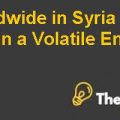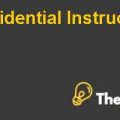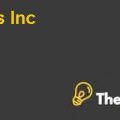
Portfolio Assignment Case Solution
Question 1
a).Investment policy Statement for John
Introduction
This investment policy statement is created for John as he expects to earn a real rate of return of 5% per year for the next years. As the current rate of inflation is 1.5% per year therefore, a nominal rate of return to cover all the needs of John would be 6.5% for the next several years.
Current Assets: $30000+$250000=$280000
1 year loss estimate (Assumed): 15%-18%
Risk & Return Objectives
Long Term Growth & Capital Preservation
Risk Profile: Moderate
Time Horizon: More than 5 years
Short Term Liquidity Needs: Yes
Return Goal: 5%+1.5% + 6.5%
Constraints:
The returns of the funds will be monitored with the benchmark funds and the standard deviation should not exceed in any year more than 10%. The probability for value at risk above 10% is very low as John does not want his portfolio to decline by this.
b).
The current portfolio of John comprises of Stocks and treasury securities. Although, a major portion of his investment is invested in risk free assets so the risk would be low and less than 10%. However, the returns might not be enough to achieve a target real return of 5% per year for John. Moreover, the annual inflation would also be 1.5%, therefore, the current portfolio does not suit the needs of John.
c).
The recommended allocations for John would be to invest 40% in corporate bonds, 30% in real estate, 10% in domestic equity, 5% in international equity and 15% in commodity stock mutual fund. Based upon these allocations the total expected return for John would be 8.45% and the standard deviation would be 8.30%. These are the recommended allocations because higher allocations for bonds and real estate are proffered as bonds have fixed income and real estate has negative correlation with other asset classes. Therefore, a diversified portfolio of assets would be created which would maximize the returns and minimize the risk and also meet the risk and return objectives of John.
d).
The pros and cons for John of investing in different assets would be as follows:
Real Estate: The advantages of investing in real estate are that they have low or negative correlation with other asset classes so diversification advantages could be created and the disadvantages are that the risk of loss is very high and its magnitude is also high.
Commodities: The advantages of investing in commodities are high returns and fixed returns for a longer period of time. The disadvantages are that understanding commodity investments is complex and it is also risky.
Private equity: The advantages are simply higher returns however, the disadvantages are the risk of huge losses due to the volatility in the asset prices. The choice of right stocks is also a complex decision to be made by an investor like John.
Question 2
a).
Looking at all the three portfolios, it could be seen that all the three portfolios offer an acceptable return for their relative level of the risks which fairly compensates for it. A higher risk is compensated with a higher return and vice versa. The entire three portfolios are acceptable for the potential investor under the investor’s IPS but I would recommend the investor to invest only in portfolio 2 or 3 because his rating for risk aversion is 6 on the questionnaire scale of 1-10. Although he could invest in portfolio 3 also however, there would be high value at risk by investing in portfolio 1, which has a standard deviation of 18% which is quite high for a return of 12%. Being risk averse, he is recommended to invest in portfolio 2 and 3 only.................
This is just a sample partial case solution. Please place the order on the website to order your own originally done case solution.












